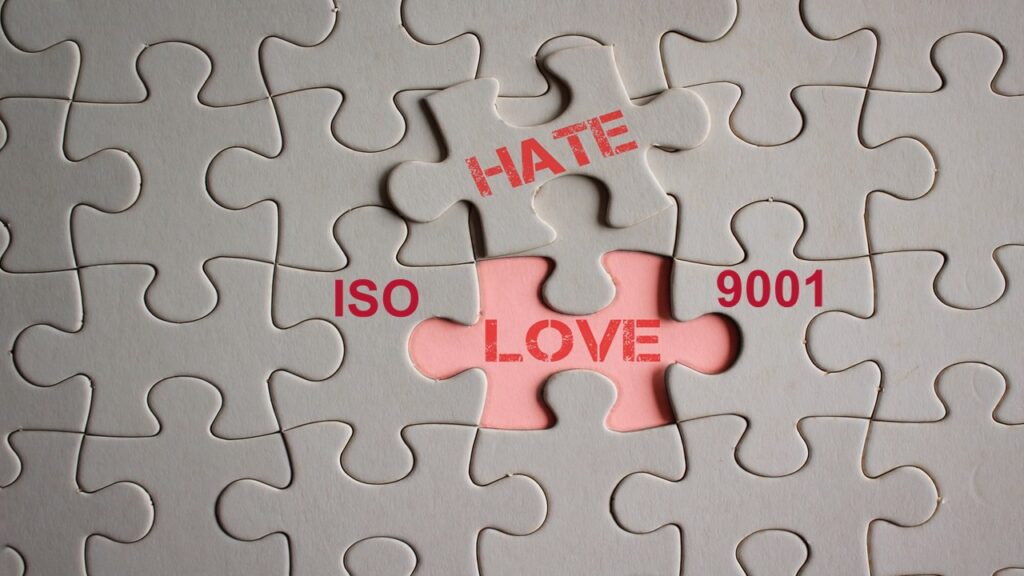The Love-Hate Relationship with ISO 9001:2015 Quality management is a vital aspect of any organization’s success. For decades, the ISO 9001 standard has been the gold standard for quality management systems worldwide. Many companies have embraced ISO 9001 and have seen significant improvements in their operations. However, there are also those who harbor a love-hate relationship with this well-regarded standard. In this blog, we’ll explore the reasons behind this complex relationship and the potential for improvement in the ISO 9001 framework.
The Love:
Relationship with ISO 9001:2015, with its focus on processes, customer satisfaction, and continual improvement, offers several advantages that organizations genuinely love:
Improved Quality: ISO 9001 helps companies consistently deliver products and services that meet or exceed customer expectations. This results in increased customer satisfaction and loyalty.
Enhanced Efficiency: The standard encourages organizations to streamline their processes, reduce waste, and operate more efficiently, ultimately leading to cost savings.
Global Recognition: Relationship with ISO 9001:2015 is internationally recognized, which can open doors to new markets and partnerships, boosting an organization’s reputation and credibility.
Risk Mitigation: ISO 9001’s systematic approach to risk management helps companies identify potential problems and address them proactively, reducing the likelihood of costly mistakes.
The Hate:
Despite the clear benefits, there are valid reasons why some individuals and organizations harbor a degree of resentment towards Relationship with ISO 9001:2015
Excessive Bureaucracy: Implementing ISO 9001 often involves extensive documentation, which can be viewed as excessive and time-consuming. This bureaucratic burden can lead to frustration, especially in smaller organizations.
Lack of Customization: ISO 9001 is a one-size-fits-all standard. Some organizations feel it doesn’t cater to their unique needs or industry-specific requirements, leading to a sense of rigidity and frustration.
Audit Anxiety: ISO 9001 certification requires regular audits, which can be stressful and time-consuming. The fear of non-compliance and the pressure to maintain certification can create tension within the organization.
Perceived Cost: Implementing Relationship with ISO 9001:2015 comes with associated costs, such as training, audits, and documentation. Some organizations may perceive these costs as a burden, particularly if they do not see immediate returns on their investment.
Finding Common Ground
While the love-hate relationship with ISO 9001 is prevalent, it’s essential to consider that ISO 9001 can be tailored to fit an organization’s unique needs. Here are some strategies to find common ground and make ISO 9001 more manageable:
Streamline Documentation: Instead of seeing documentation as a burden, view it as an opportunity to improve your processes and ensure consistency. Embrace technology to make the process more efficient.
Customize Where Possible: While ISO 9001 has specific requirements, it allows for flexibility in how you meet those requirements. Tailor the standard to fit your organization’s needs, while still meeting its fundamental principles.
Embrace Audits: Instead of dreading audits, use them as opportunities for feedback and improvement. Engage with auditors to learn from their insights and continuously enhance your quality management system.
Measure ROI: Keep a close eye on the return on investment from ISO 9001 implementation. Monitor improvements in quality, efficiency, and customer satisfaction to validate the effort and resources invested.
Conclusion
The love-hate relationship with ISO 9001:2015 is a reality for many organizations. While the standard has its drawbacks, its advantages in terms of quality, efficiency, and reputation are undeniable. The key to making ISO 9001 work for your organization lies in finding a balance that suits your unique needs and a commitment to continual improvement. By addressing concerns and leveraging the benefits, you can turn this love-hate relationship into a successful and mutually beneficial partnership.

